Abstract
This chapter focuses on water quality, air quality, and global warming, with the objective of providing a basic introduction to environmental policy in Japan ( Note 1 ). Having experienced severe water and air pollution especially during the 1950s and 1960s, measures were taken, resulting in a reduction of pollutants during the 1970s and 1980s. Global warming became a very significant environmental problem in the 1990s.
1. Introduction
Japan experienced severe problems associated with pollution. In the 19th century, local residents in the downstream part of the Watarase River suffered from pollution caused by a copper mine upstream. A booklet titled "Water Environmental Management in Japan" includes the details of such history ( Note 2 ), together with overall policies and data related to the water environment in Japan.
The outbreak of the Minamata Disease, which occurred as a result of methylmercury poisoning, was first reported in 1956. People were affected after eating large quantities of fish that had ingested and accumulated methylmercury, after the toxin was discharged into Minamata Bay by chemical plants ( Note 3 ).
During the 1960s, environmental pollution problems increased. For example, an increase in organic matter decreased oxygen levels in many rivers, bays, and lakes, creating a number of adverse effects for the local people including pungent odors, diminished fish population, and poisonous plankton and bacteria. Also, the number of asthmatic patients increased in certain areas close to large petrochemical factories. The air in the neighborhood was found to be polluted by sulfur oxide (SOx) ( Note 4 ).
Thus, Japan's environmental policy was strengthened. The Basic Law for Environmental Pollution Control, legislated in 1967, was among the first "basic laws" in Japan, stating basic policy frameworks such as the role of different actors.
In the 1990s, climate change became the focus of the environmental problems, and the Basic Law for Environmental Pollution Control was amended and became the Basic Environment Law in 1993. The Basic Environment Law includes provisions on the objectives, responsibilities of different actors, annual reports, the basic environment plan, environment quality standards, and the Environment Council, among others ( Note 5 ).
The government strengthened its organization for the environment. The Environment Agency was established in 1971, and various policy measures were taken to reduce pollution during 1970s and 1980s.The Environment Agency became the Ministry of the Environment (MOE) in 2001. Since 2012, the responsibilities of the MOE have included water and air pollution control, waste management, nature conservation, global environment, and nuclear regulation ( Note 6 ).
Private companies also strengthened their functions for the environment in order to avoid problems including punishments from the government. The Act on the Improvement of Pollution Prevention Systems in Specified Factories, legislated in 1971, obliges specific kinds of factories to have managers with government licenses to be in charge of pollution control ( Note 7 ).
2. Protecting Environmental Quality of Water
2-1 Regulations on Effluents
In order to regulate effluents discharged by factories and other establishments, the Water Pollution Control Law was legislated in 1970 ( Note 8 ). Also, in order to impose more stringent regulations in the Seto Inland Sea areas where pollution was more serious, the Interim Law for Conservation of the Environment of the Seto Inland Sea was legislated in 1973. The Seto Inland Sea is the body of water located between the main island of Honshu and the islands of Shikoku and Kyushu, which, at the time, needed special measures to limit the total amount of pollutants. The interim law became permanent in 1978. In order to reduce pollution in lakes such as Lake Biwa, which provides water for many people including those living in Kyoto and Osaka, the Law Concerning Special Measures for the Conservation of Lake Water Quality was legislated in 1984.
The central government and local governments cooperate closely to protect water quality in accordance with the three laws (Water Pollution Control Law, Law Concerning Special Measures for Conservation of the Environment of the Seto Inland Sea, Law Concerning Special Measures for Conservation of Lake Water Quality). The laws have many provisions, among which are regulations covering the level of pollutants in effluents. Most of the regulatory administration is carried out by local governments. Local governments can establish regulations that are more stringent than the national regulations.
Under the Water Pollution Control Law, the MOE sets standards for effluents from factories and other commercial facilities that discharge wastewater into public waters such as seas, rivers, and lakes ( Note 9 ).
There are two categories for effluent standards. One category is related to the protection of human health and includes standards on pollutants such as mercury and cadmium, which can cause diseases. Another is related to the protection of the living environment and includes standards such as Biochemical Oxygen Demand (BOD) and Chemical Oxygen Demand (COD), which are indicators of water quality for organic contamination. High levels of organic contamination can cause a shortage of oxygen in the water. This category also includes nitrogen and phosphorus, which act as fertilizers to increase the growth of undesirable plankton and algae.
Stricter standards are applied to some areas. For example, total volumes of some pollutants are regulated, in addition to the densities, in Tokyo Bay, Ise Bay, and the Seto Inland Sea. Also, local governments in some areas set effluent standards to be stricter than the uniform national standards.
Those who manage factories and other commercial facilities which discharge effluents are obliged to measure the pollution level of the effluents and keep records of the measurements in accordance with the order issued by the MOE. The Minister of the Environment, prefectural governors, and mayors of designated cities request reports from factories and other commercial facilities on their effluents, and conduct on-site inspections when necessary. If it is found that any effluent violates the standards, punishment may be enforced. Also, an order may be issued to modify the construction of the facility or the method of wastewater treatment ( Note 10 ).
Regulations are effective only when proper enforcement is carried out. In order to ensure proper enforcement, the MOE surveys the enforcement of all three laws, and publicizes the results. In FY2011, the number of facilities subject to effluent control totaled 266,860, including 65,648 hotels, 30,280 car washes, and 28,968 livestock farms. Of these facilities, 38,882 were subject to on-site inspections resulting in 7,650 cases of administrative guidance. Twelve administrative orders were issued to improve the situation, and eight infringements of effluent standards were found ( Note 11 ).
2-2 Policy Measures for Household Wastewater
Effluents containing pollutants such as organic matter, phosphorus, and nitrogen from household activities have been a major cause of pollution of public waters, especially around big cities. In order to treat wastewater from households, the government has been promoting the construction of sewage systems. For local governments operating sewage systems, financial support was provided by the central government. Also, the central government and local governments jointly subsidize the Japan Sewage Works Agency, which has been providing technical support on sewage systems to local governments ( Note 12 ). For areas without sewage systems, mostly in mountainous areas or areas with low population densities, rural community wastewater treatment facilities and household wastewater treatment facilities, called johkaso (septic tank), have been developed with the aid of subsidies.
In order to reduce pollution from households, efforts have been made to disseminate information on water quality so as to raise public awareness. The MOE and local governments have created various publications and websites and have called for a more environmentally sound use of water. Along with the heightened public awareness, producers of detergents have changed their products to those which are less harmful to the environment. For example, detergents without phosphorus were developed in the 1970s, and most of the detergents in Japan do not contain phosphorus today.
Through the above-mentioned measures, pollution from households was reduced. For example, oxygen demand, nitrogen, and phosphorus discharged from households, industry, and other (including agriculture, stockbreeding, and fishery) sectors in Tokyo Bay were reduced as shown in Figures 1, 2, and 3, in spite of the increase in population and economic activities in the neighboring area.
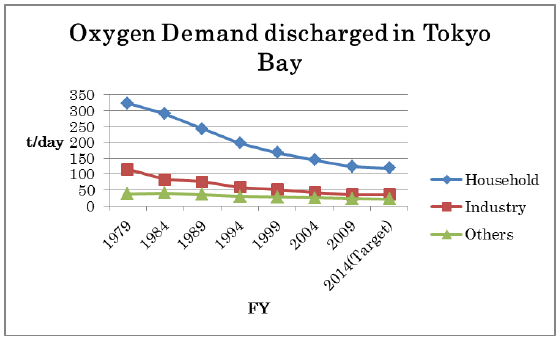
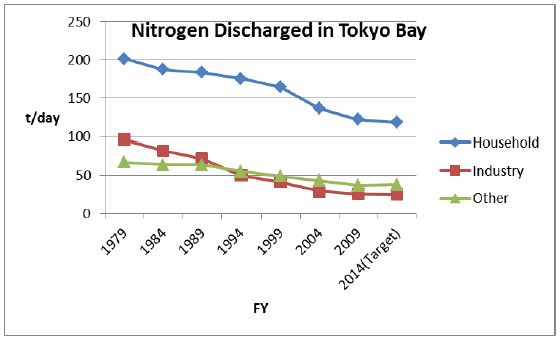
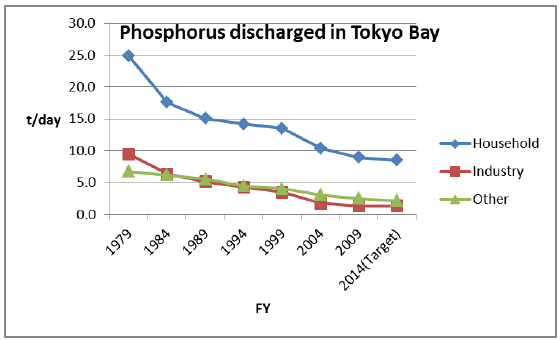
2-3 Monitoring and Publicizing Water Quality
Local governments monitor the quality of water in seas, rivers, lakes, and groundwater, according to the common items and methods set by the MOE, and compare them with environmental quality standards. Studies are made on each point where any substance exceeds the standard, and measures are taken to meet the standard. The MOE collects and publicizes the results and other information related to water quality so as to raise public awareness and encourage further action to protect the environment.
Water quality improved, and the non-compliance rate of the standards on human health items declined rapidly during the 1970s ( Note 16 ). Most of the excesses in human health items had been handled, and most of that still remaining were found to be from natural causes, such as high arsenic contents in nearby rocks or soil. Monitoring continues for sites in which the cause of the excess has not been determined ( Note 17 ).
Organic contamination, which is measured by oxygen demand, improved in most rivers, but improvements in lakes were smaller, as shown in Figure 4.
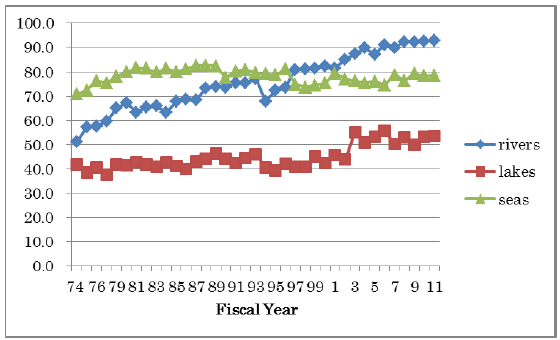
In order to encourage efforts to make further improvements, all rivers and lakes are ranked by water quality in terms of organic contamination, and the top five cleanest and top five dirtiest rivers and lakes are determined. These rankings are publicized so as to raise awareness of the water environment. In addition, the top five rivers and lakes which had the largest improvements in water quality are also publicized, so as to recognize the efforts that have been made. Sightseeing businesses on rivers and lakes are especially interested in raising the ranking for their sites. In addition to the annual publication by the MOE, a website on water quality has been established to show information on water quality to the public ( Note 19 ).
Swimming beaches pose a good opportunity for raising awareness in water quality among the public and local business community. In the beginning of summer each year, the water quality of swimming beaches is graded and publicized. If any beach is found to be lower than the lowest passing grade, swimming is not allowed ( Note 20 ). Also, in 2006, the MOE selected the 100 best beaches and publicized information related to their environment, access, etc., through its website ( Note 21 ). Although the website is in Japanese, pictures and local maps can be seen by clicking on the beaches in the map.
As for groundwater, regular measurements are made by prefectures and the results and causes of pollution are publicized by the MOE. In FY2013, for general monitoring, groundwater from 3,692 wells was measured, among which 218 (5.9% of the total) contained substances exceeding the environmental quality standards. Among these 218 wells, the largest number, 117, had nitrate nitrogen/nitrite nitrogen in excess of the standard ( Note 22 ). Such wells are often found in areas where a large amount of fertilizer is used or manure from livestock is not treated properly. Household wastewater also causes such pollution. Since babies who are drinking water with excessive nitrate nitrogen/nitrite nitrogen can suffer from anemia, environmentally sound management is called for in agriculture and stockbreeding, so as to emit less nitrogen into the groundwater. In addition, follow-up monitoring is conducted on wells which have exceeded the standards in the past and other wells located around them. In FY2013, 9,723 wells in total were monitored.
2-4 Policies Related to River Management, Drinking Water, and Non-point Sources
The 1997 amended River Law added improvement and conservation of the environment to the list of the fundamental tasks of river administration under the Ministry of Land, Infrastructure, Transport and Tourism ( Note 23 ). Projects have been carried out to improve water quality and protect the natural environment. For example, water in some dam lakes is purified by aeration (mixing air into water) ( Note 24 ). The Japan Water Agency, which is responsible for water resource development such as dam construction in major river systems in Japan, carries out related environmental activities such as aeration and installation of partitioning fences to prevent the growth of algae ( Note 25 ).
Efforts by public organizations to protect the quality of drinking water are important, too. To this end, the Drinking Water Sources Law and the Law concerning Special Measures for Water Quality Conservation at Water Resources Area in Order to Prevent the Specified Difficulties in Water Utilization ( Note 26 ) were established in 1994. The Ministry of Health, Labour and Welfare publicizes activities by municipalities to protect drinking water sources ( Note 27 ).
Problems remain in water quality in some lakes. The Lake Water Study Committee of the MOE agreed that additional action was needed in 2004 because water quality in lakes in terms of oxygen demand was not satisfactory. In 2005, the Law Concerning Special Measures for the Preservation of Lake Water Quality was amended, to include measures to reduce pollution from non-point sources such as agriculture. For example, more appropriate use of fertilizers is encouraged in certain areas designated under the law to reduce the inflow of nitrogen and phosphorus to lakes. The amended law also includes measures to preserve the natural vegetation around lake shores, which is effective for improving the quality of water.
3. Protecting Environmental Quality of Atmosphere
3-1 Reducing Emissions from Facilities
Air pollutants are generated mainly from facilities such as factories and mobile sources such as motor vehicles. Major problems during the 1960s and 1970s were caused by soot and smoke from factories. In order to reduce air pollution, the Air Pollution Control Law was legislated in 1968 ( Note 28 ). The law has provisions to protect air quality by measures such as those to control emissions of soot and smoke and particulate matters from factories.
As for factories, national emission standards are set by the Minister of the Environment, but prefectural governors can set more stringent standards in areas under their jurisdiction. Regulation duties are conducted by prefectures and large cities.
Any person who plans to establish a soot and smoke emitting facility must provide information such as the kind of proposed facility to the governor of the prefecture. If the governor finds that the estimated volume and concentration of the soot and smoke fails to meet the emission standard, he or she may order the notifying person to modify the plan.
Those who manage facilities that emit soot and smoke must measure and keep record of the volume and concentration of the soot and smoke generated according to the technical standards set by the MOE. If the governor of the prefecture finds that the emission is likely to exceed the standards continuously, he or she may order the person to improve the method of operation.
In order to ensure proper enforcement of the law, the MOE surveys the status of enforcement and publicizes it annually. For example, in FY2012, the number of notifications from soot and smoke emitting facilities was 217,132, among which 62.9% were boilers, 16.6% were diesel engines, and 4.4% were gas turbines. Onsite inspections were conducted at 23,498 facilities, of which 4,136 cases of administrative guidance were made, and one administrative order was issued ( Note 29 ).
Other laws regulating special facilities are also used for protecting air quality. For example, the Electricity Business Act ( Note 30 ) has provisions for regulating power plants, and are used to ensure that the emissions from fossil fuel combustion in power plants do not exceed certain limits.
In addition to environmental regulations, special loans were provided by governmental financial institutions for environmental investments to encourage factories to install facilities to reduce pollution, especially during the 1970s when such financial needs for environmental investments were high. During this period, the capacity of SOx removal facilities, for example, increased rapidly, as shown in Figure 5.
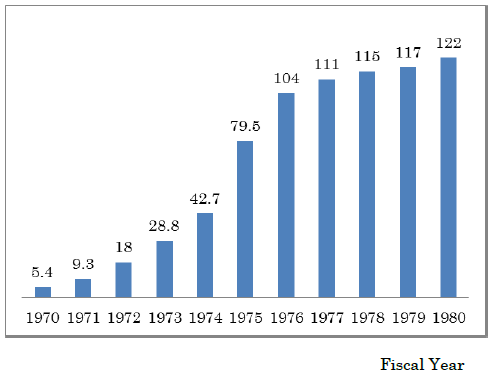
3-2 Reducing Air Pollution from Mobile Sources
Although the regulation on factories effectively reduced pollution from factories during the 1970s, air pollution worsened during the 1980s mainly in roadsides because of the increased number of automobiles. In order to mitigate roadside air pollution from mobile sources, the Air Pollution Control Law has provisions including utilizing other laws to protect air quality. Major actions under the law include the following:
- The Minister of the Environment establishes maximum permissible limits on the amount of exhaust gases from motor vehicles and also from non-road special motor vehicles such as construction machinery.
- The Minister of Land, Infrastructure, Transport and Tourism establishes necessary matters on the control of emissions of motor vehicles exhaust under the Road Transportation Vehicles Act, ensuring to secure the maximum permissible limits set by the Minister of the Environment. Automobiles which emit exhaust gas exceeding the limit are not allowed to be sold, and do not pass periodical car inspections.
- The Minister of the Environment sets maximum permissible limits on the quality of automobile fuel where necessary to prevent air pollution caused by automobile exhaust gases. For example, regulation on the sulfur content in diesel oil has been strengthened as shown in Table 1.
| Year | 1976 | 1992 | 1997 | 2004 | 2007 |
|---|---|---|---|---|---|
| Sulfur content (ppm) | 5,000 | 2,000 | 500 | 50 | 10 |
- The Minister of Economy, Trade and Industry establishes necessary matters concerning the regulation of automobile fuel by an order under the Act on the Quality Control of Gasoline and Other Fuels, ensuring to secure the maximum permissible limits set by the Minister of the Environment. Gasoline and other fuels which contain more sulfur and other pollutants than the limits are not allowed to be sold.
In order to further mitigate emissions from motor vehicles, the Law Concerning Special Measures for Total Emission Reduction of Nitrogen Oxides and Particulate Matters from Automobiles in Specified Areas was legislated in 2001, by amending the Law Concerning Special Measures for Total Emission Reduction of Nitrogen Oxides from Automobiles in Specified Areas ("Particulate Matters" was added to the title of the law). Under the fundamental plans to reduce the total volume of nitrogen oxides and particulate matters emitted from automobiles, special restrictions are set in areas of large concentrations of motor vehicles such as the Tokyo Metropolitan area. Only automobiles that emit nitrogen oxides and particulate matters below the level of certain standards, which are more stringent than the national standards, are allowed in these areas.
Regulations are revised or added when necessary. For example, new regulations over volatile organic compounds (VOCs) started in 2006 ( Note 33 ).
3-3 Compensation for Health Damages Caused by Air Pollution
Since many factories and automobiles caused air pollution, it was difficult to decide the amount of compensation to be paid to and by the parties involved. The Act on Compensation, etc. of Pollution-related Health Damage, legislated in 1973, improved the situation. The law has provisions to designate areas severely affected by air pollution and diseases caused by air pollution such as asthma and bronchitis. Patients of the designated diseases in the designated areas are compensated, and 80% of the money is provided by facilities emitting SOx, collected in accordance with the amount of SOx emission, and 20% is provided by taxation on automobiles. Since air pollution was reduced, designation of the areas ended in 1988, and only patients who had been acknowledged up to that time have been compensated since then.
3-4 Monitoring and Publicizing Air Quality
Atmosphere quality is measured at monitoring stations mostly by local authorities. There are two types of stations: roadside air pollution monitoring stations and ambient air pollutions monitoring stations (general stations). There were 422 roadside stations and 1,489 general stations as of the end of March 2012 ( Note 34 ).
Data on air quality are publicized by the MOE through the homepage of the Atmospheric Environmental Regional Observation System ( Note 35 ). The system has a nickname called "Soramame-kun," and efforts have been made to make it interesting to the public. Although the homepage is in Japanese, data can be seen relatively easily by non-Japanese speakers by clicking on any part of the map.
Through the measures mentioned above, concentrations of pollutants in the atmosphere have decreased over the years, in spite of economic growth and an increase in the number of automobiles. The average annual concentration of SO 2 , NO, NO 2 , and SPM in the atmosphere dropped, as shown in Figures 6, 7, and 8. In this century, Japan is among the countries where emissions of SOx and NOx are the lowest in the world, as shown in Table 2.
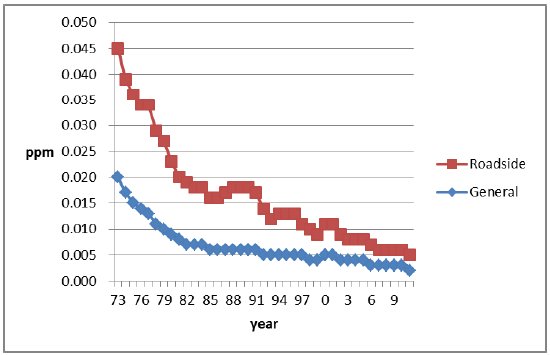
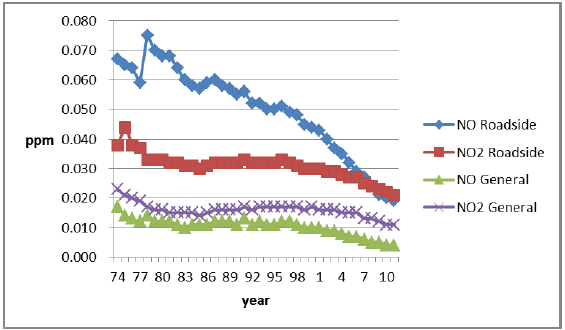
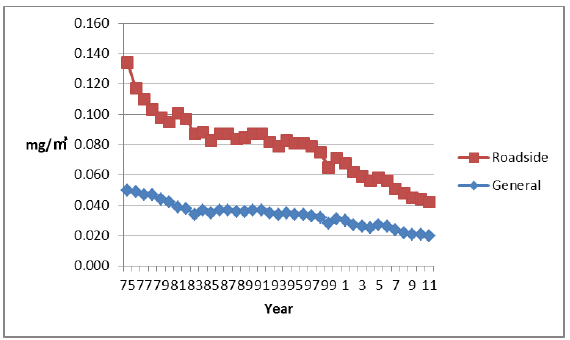
| U.S. | Korea | France | UK | Germany | Japan | |
|---|---|---|---|---|---|---|
| SOx(㎏/GDP) | 0.7 | 0.3 | 0.2 | 0.2 | 0.2 | 0.2 |
| NOx(㎏/GDP) | 1.0 | 1.0 | 0.6 | 0.5 | 0.5 | 0.5 |
| SOx(㎏/person) | 27.8 | 8.3 | 6.5 | 4.8 | 5.5 | 6.0 |
| NOx(㎏/person) | 43.3 | 24.5 | 17.8 | 17.8 | 16.7 | 14.0 |
Since the enactment of the Law Concerning Special Measures for Total Emission Reduction of Nitrogen Oxides and Particulate Matters from Automobiles in Specified Areas in 2001, pollutants from domestic sources have been further reduced.
Recent problems in air pollution concern PM2.5 (particulate matters with diameter less than 2.5 micro meters). Sources of PM2.5 are often beyond national boundaries, and measures to reduce such pollution involve international cooperation.
4. Protecting the Earth from Climate Change
4-1 International Agreements to Reduce Greenhouse Gases
In 1992, an agreement was reached for the United Nations Framework Convention on Climate Change. It is an international treaty to consider what could be done to limit climate change, and to cope with the impacts ( Note 40 ).
In 1997, Japan hosted the Third Conference of the Parties for the United Nations Framework Convention on Climate Change in Kyoto, at which the Kyoto Protocol ( Note 41 ) was reached. The Kyoto Protocol included numerical targets of greenhouse gas emissions reduction for some countries during its first commitment period (2008-2012) compared to 1990 levels.
Figure 9 shows CO 2 emissions from fuel combustion in the world. Figure 10 shows CO 2 emissions from fuel combustion per person for selected countries in 2011. Countries marked with ★ are those which committed themselves to the numerical target for the first commitment period under the Kyoto Protocol.
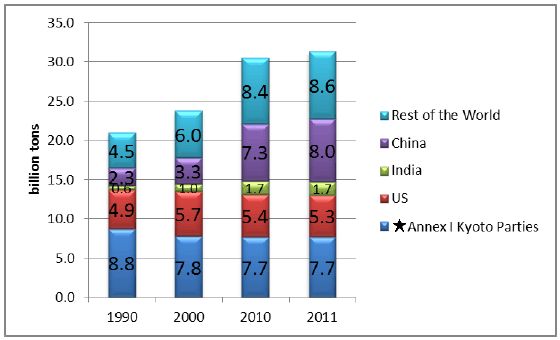
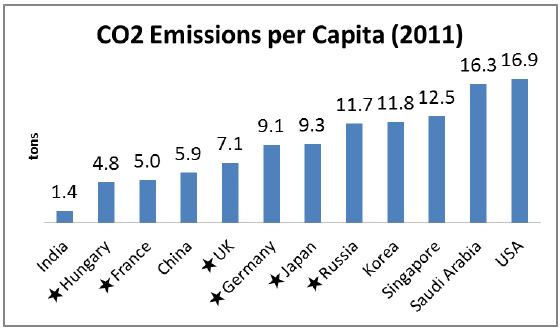
Efforts have been made in Japan to meet the target. In 1998, the Act on Promotion of Global Warming Countermeasures was legislated ( Note 44 ). The law prescribes responsibilities of the central government, local governments, businesses, and citizens to cope with global warming. The central government established the Kyoto Protocol Target Achievement Plan based on the law.
In order to raise awareness on global warming among the public, the MOE has been carrying out national campaigns and calling for action. For example, a campaign promoting a lifestyle to reduce CO 2 emissions called "Team Minus 6%" started in 2005. It called for actions such as a reduction in the use of air conditioning and the promotion of eco-driving. It also encouraged "COOL BIZ," which promotes a "business style" of dressing for working in offices at a comfortable temperature of 28 degrees Celsius ( Note 45 ).
Although Japan has not committed itself to the numerical target of the second commitment period of the Kyoto Protocol, efforts are continuing to further reduce greenhouse gas emissions.
4-2 CO 2 , Economy, and Energy
Figure 11 shows CO 2 emissions per GDP. Since a large proportion of the anthropogenic emissions of greenhouse gases are CO 2 emissions from fossil fuel combustion, a reduction in the use of fossil fuels by energy conservation is effective to mitigate global warming and also contributes to the economy.
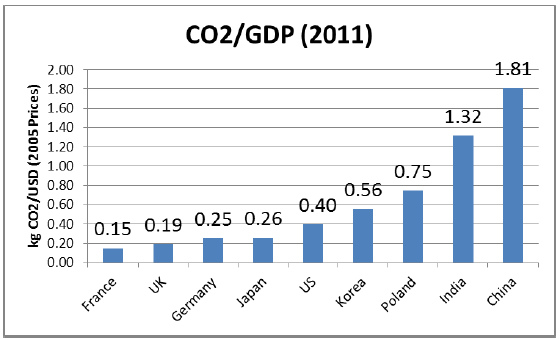
As shown in Figure 12, Japan is one of the countries where less energy is used per unit of GDP. Energy conservation in Japan has contributed not only to the reduction of greenhouse gases, but also to the protection of the economy and the people from higher energy prices.
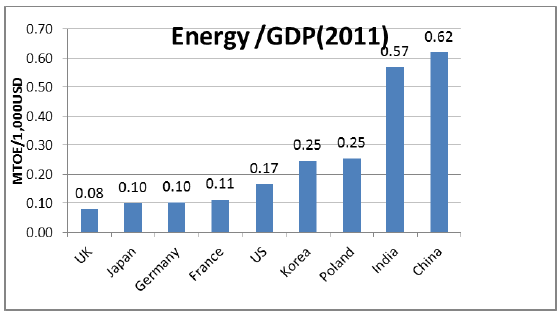
The other side of the energy use per GDP is GDP per energy use. Most countries have been making progress in achieving an increase in GDP per energy use, as shown in Figure 13. Japan stepped up energy efficiency and achieved rapid economic growth during the 1970-80s when the world economy was hit by an increase in oil prices. Its GDP per energy use stepped back during the 1990s, but is making progress through policies on climate change in this century.
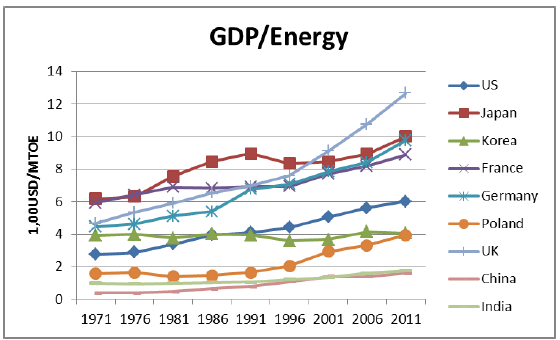
Per Total Primary Energy Supply measured in tons of oil equivalent
The Act on the Rational Use of Energy, which was created in 1979 during the second energy crisis, is used in the reduction of CO 2 emissions from energy sources. It is used to implement the measures required for the rational use of energy with regard to factories, transportation, buildings, and machinery and equipment ( Note 49 ).
The following measures, among others, are included in the Act:
- A business operator that consumes large amounts of energy must appoint an energy manager who has a qualified license to monitor the work related to rational energy utilization and report the status of their energy utilization to the government. A license is awarded to a person who has passed the examination or who has been authorized by the Ministry of Economy, Trade and Industry upon completing a qualification course.
- The Ministry of Land, Infrastructure and Transport establishes standards to which building owners should refer in making decisions for rationalizing energy use in their buildings. Construction clients and owners who intend to construct large buildings must submit energy-saving measures to the competent authorities before the start of construction.
- Automobiles, air conditioners, refrigerators, television sets, copying machines, and other equipment specified in the Government Order must meet energy efficiency standards. The standards are set based on the product in the market having the highest energy efficiency of all of the products of the same group. Such equipment must be marked to show their energy consumption efficiencies to assist consumers' choice ( Note 50 ).
Technology has been improved to enhance efficiency in the energy sector, and is supported by consumers and other users. For example, passenger vehicles increased fuel efficiency as shown in Figure 14. Energy efficiency of electric appliances was increased by measures such as improved insulation in refrigerators. Also, technologies were developed and introduced for increasing thermal efficiency of thermal power plants and reducing electricity loss by power transmission, transformation and distribution as shown in Figures 15 and 16.
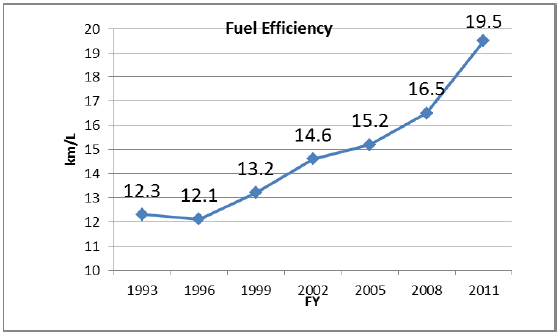
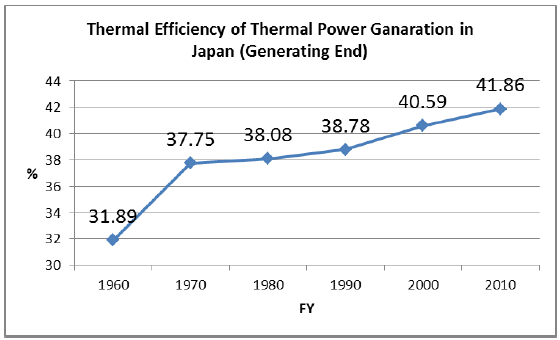
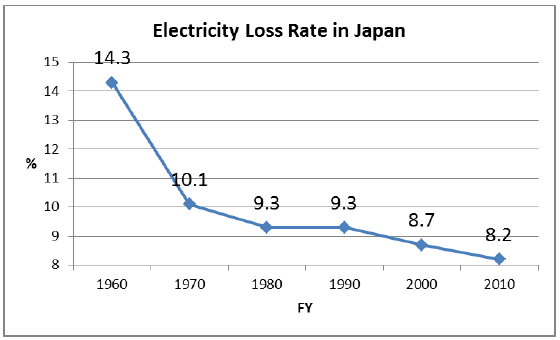
Efforts have been made to ensure safe and comfortable railways, which have substantially less energy intensity compared with other passenger transport means, as shown in Figure 17.
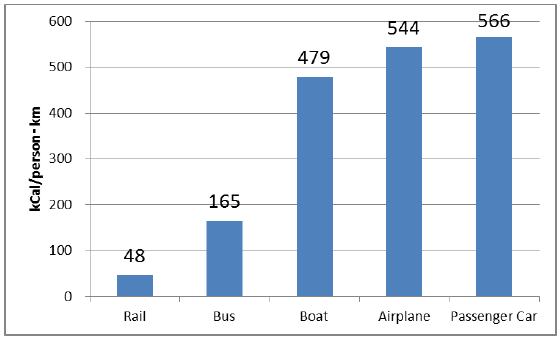
Renewable energies contribute to the reduction of CO 2 emissions. The government has been promoting technology development, production, and use of renewable energies. New Energy and Industrial Technology Development Organization is promoting research and development technologies including those for renewable energy sources ( Note 55 ). Also, electric utilities are obliged to purchase electricity generated by renewable energy sources at specified prices ( Note 56 ).
However, CO 2 emissions from energy use in Japan have decreased only in the industry sector and have increased in other sectors compared with the numbers in 1990, as shown in Figure 18. It is because that energy consumption in household, commercial and transport sectors has increased, and it is not only a problem for the environment but also the economy and supply security for emergency occasions such as natural disasters. Further efforts are necessary.
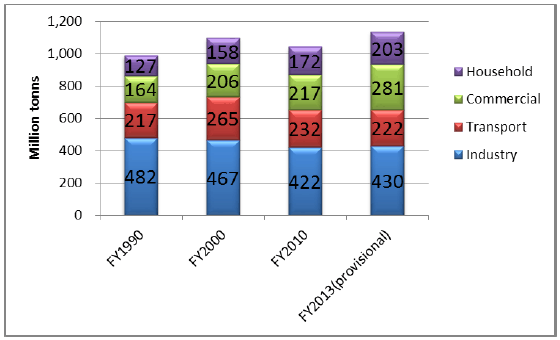
Conclusion
Water and air pollution in Japan during the 1950s and 1960s imposed very high costs on residents, businesses, and the government of Japan. However, during the 1970s and 1980s, with the introduction of environmental policy measures, Japan's environmental quality improved at the same time as achieving a rapid economic growth. If these actions had been taken earlier, the costs incurred by the pollution could have been reduced substantially.
However, challenges in the environment still remain, and efforts must be made in many areas including those to mitigate the climate change. Establishing laws and setting proper standards are only the first step. Laws are only effective after they are properly enforced. Both capacity of public organizations for law enforcement and understanding among the private sector are needed for a successful reduction of pollutants.
February 6, 2015


